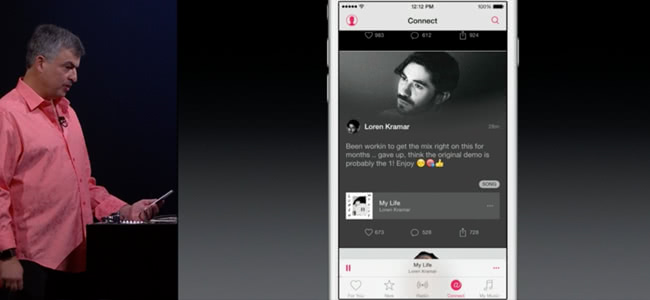If you’ve been following the hoopla surrounding Apple Music, you might know that Jimmy Iovine recently revealed the true agenda behind the tech giant’s new music subscription service, and it has nothing to do with getting consumers to pay $10 a month for music.
As Business Insider reports, Iovine said the company’s real plan is to get every single artist in the world to put their music on the platform, no matter how small. Unlike Tidal, Apple Music wants to cater its service to the artists who need the most help.
“You come out, you build this service, and a lot of it is based on free,” he said. “So if you have a hit record, you’re only being paid on 20% of it, because 80% of it is free. So this generation [of] artists, the next five to seven years, they have got to pay for the future?”
“What’s that? No. No! That’s wrong from my viewpoint. From a musician’s standpoint. 90% of [artists] were broke last week! These aren’t trust-fund people coming in making this music, y’know! Maybe there’s eight artists in the world that can just do anything they want financially.”
“But there’s thousands of artists who could use a couple of bucks to get by and do this stuff right. So if you get 100m streams and you’re only really being paid on 20 million, that doesn’t work for the artist. Record companies will be here forever, but those artists will not be here forever.”
As Business Insider notes, the company appears to be putting its considerable bankroll where its rhetoric is. The huge marketing push surrounding Apple Music didn’t target consumers or tout the famous musicians who’ve signed onto the service.
Instead, one of Apple’s first TV spots promoting its new Music service pointed out that kids making music in their bedrooms could upload their work to the platform and have it sit alongside releases by superstars. Apple is well and truly pulling for the little guy.
Even during Monday morning’s Apple Keynote address, which proved a sharp contrast to Tidal’s all-star boondoggle some months back, senior VP of Intel Software and Services Eddy Cue proudly proclaimed that “even unsigned artists” will be able to upload their content to Apple Music profiles.
As Digital Music News reports, Cue followed up by highlighting an unsigned artist on stage and playing a snippet of his latest tune. It was a pretty impressive moment. Not only was Apple promoting the fact that they’re out to help struggling musicians, they were putting it front and centre.
Except, the “unsigned artist” they put front and centre, Loren Kramar, doesn’t actually exist. After the folks at Digital Music News did some digging, they discovered that there is no working musician named Loren Kramar.
Well, obviously there could be, and the Loren Kramar featured during the keynote seems to have written a song, but he’s far from what most of us think of when we think “struggling unsigned musician”. 26-year-old Kramar is a visual artist by trade and has zero presence as a musician online.
The New York City resident doesn’t have any videos on YouTube, no Facebook page as a musician, no releases on Spotify or iTunes, and no history of performing live. He did, however, have a Twitter account, which, as The Next Web notes, conveniently launched minutes after Cue name-checked him.
[include_post id=”450567″]
As it happens, Joe Weinberger, an associate of Kramar’s, used to be an A&R rep under Jimmy Iovine at Interscope. According to Digital Music News, Iovine tapped Weinberger to find him an unsigned artist to feature during the keynote, at which point he provided an artist that didn’t really exist yet.
The company then promptly patted themselves on the back for supporting unsigned artists. Frankly, if Apple needed an unsigned artist to promote, they could’ve thrown a rock and hit one of the literally thousands of hard-working unsigned musicians with actual fan bases and discographies.
“See, as a truly ‘unsigned artist’ who has built my career on my own, touring relentlessly and navigating the ever-changing music industry… it’s a direct insult to us when you slap us in the face with this ‘artist’ who hasn’t put in the blood sweat and tears like we have,” writes Ari Herstand.
Far from struggling, The Next Web reports that Kramar had a rather “upmarket childhood”. The son of a wealthy scrap metal magnate, Kramar grew up in the San Fernando Valley and attended the prestigious Campbell Hall, the alma mater of many Hollywood kids. He took Tony Danza’s daughter to winter formal.
While we have nothing against Kramar’s posh background and upmarket lifestyle, which includes donning “a pair of 1930’s pajamas from Melet Mercantile, a vintage showroom in Soho” to meet an interviewer from Capital New York, is this really the kind of ‘struggling’ artist Apple want as the face of their bid to help unsigned musicians?
Herstand questions just what Apple will do for up-and-coming musicians as opposed to their competitors, like Spotify, who feature unsigned artists in company-curated playlists, or even Tidal, who’ve publicly stated they will give artists complete access to their own analytics and fan data.
But Apple’s stunt raises another, far more curious question: why did they go to these lengths to find a fake unsigned artist? Wouldn’t it have just been easier to find an actual artist with a profile? Not only would you have given a struggling artist a significant boost, it would’ve given Apple Music some serious credibility.



































